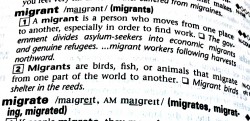Migrants in administrative language in the UK: AELINCO 2015

Migrants in administrative language in the UK[1]
1 Pascual Pérez-Paredes
2 Pilar Aguado Jiménez
3 Purificación Sánchez Hernández
Departamento de Filología Inglesa, Universidad de Murcia
Panel: Discourse, literary analysis and corpora,
Abstract
Immigration is at the heart of societal changes these days, although our current migration policies have been enacted for almost a century now. In fact, European migration started a “new epoch” in 1918 when “entry was no longer free and unimpeded” (Isaac, 2013: xi). In 2007, Spain reached an immigration rate of 10 % of the population. In the UK, this rate was 8.1 % that year and had reached its peak in 2005 with some 320.000 Non-EU citizens getting to the UK, according to the Office for National Statistics[2]. Although migration covers both emigration and immigration (Isaac, 2013:4), it is the latter that is regulated by receiving countries.
Fernández Vítores (2013: 64) contends that the EU countries use language both as an entry barrier and an integration tool. Sancho Pascual (2013:6) maintains that the existence of migrations and multicultural scenarios call for a redefinition of the identity markers of those involved in these processes. In this context, how is the immigrant represented by the administration? How does the receiving country construct the identity of immigrants?
The use of corpora has attracted the attention of researchers in the field of discourse analysis for a myriad of reasons. The exploration of attested uses of language, combined with the computational power and flexibility of existing software, have contributed enormously to the spread of this approach. In this vein, Some researchers have looked at how the identity of minority groups such as gay men (Baker, 2005) or muslims (Baker, Gabrielatos, & McEnerey, 2013) have been represented in the media. We have relied on the research methodology in Baker et al. (2008) and Baker, Gabrielatos, & McEnerey (2013) for the combination of Critical Discourse Analysis (CDA) and Corpus Linguistics (CL). Our paper examines the uses of the lemma “migrant” in two corpora of immigration law (1.2 M. tokens) and information texts (2.3 M tokens) produced by the UK immigration Authorities during the 2007-2011 five year period.
Our results reveal that the term “migrant” is used most often in its singular form in both corpora, mainly pre-modified by noun phrases that typify their adscription to five existing Visas in the context of the UK immigration Tier System, and are predominantly seen as applicants of leaves to remain in the UK. However, there are important differences between the co-texts in both corpora. While in the Administrative Law corpus migrants are mainly represented as fee providers and are subject to heavy demands from the UK administration, this very same body represents them as either highly-skilled or high-value persons in 22% of the uses in the corpus of information texts produced by the UK immigration Authorities. This paper will discuss a detailed analysis of the frequencies and collocational behaviour of the term in both corpora, and will offer insights into the representational strategies most frequently used in both corpora.
References
Baker, P. 2005. Public discourses of gay men. London: Routledge.
Baker, P. et al. 2008. A useful methodological synergy? Combining critical discourse analysis and corpus linguistics to examine discourses of refugees and asylum seekers in the UK press. Discourse & Society, 19: 273-306,
Baker, P. Gabrielatos, C. & McEnerey, T. 2013. Discourse analysis and media attitudes. Cambridge: Cambridge University Press.
Fernández Vítores, D. 2013. El papel de la lengua en la configuración de la migración europea: tendencias y desencuentros. Lengua y migración, 5:2, 51-66
Fetzer, J. S., The Evolution of Public Attitudes toward Immigration in Europe and the United States, 2000-2010, Research Report Case Study, EU-US Immigration Systems 2011/10, Italy: European University Institute, 2011.
Issac, J. 2013. Economics of migration. V. 4. London: Routledge.
Sancho Pascual, M. 2013. Dimensión lingüística de las migraciones internacionales. Lengua y migración, 5:2, 5-10.
[1] Research funded by FFI2011-30214 – Lenguaje de la Administración Pública en el ámbito de la extranjería: estudio multilingüe e implicaciones culturales (LADEX). Ministerio de Economía y Competitividad.
[2] http://www.ons.gov.uk/ons/rel/migration1/migration-statistics-quarterly-report/august-2014/index.html
Figure IIb: Word sketch, “Migrant”, LADEX 3
